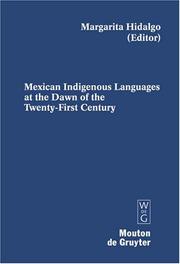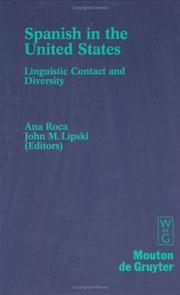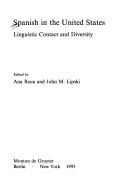| Listing 1 - 10 of 11 | << page >> |
Sort by
|
Book
Year: 1995 Publisher: Berlin de Gruyter
Abstract | Keywords | Export | Availability | Bookmark
 Loading...
Loading...Choose an application
- Reference Manager
- EndNote
- RefWorks (Direct export to RefWorks)
Book
ISBN: 9781501512629 Year: 2016 Publisher: Boston ; Berlin Walter de Gruyter Inc.
Abstract | Keywords | Export | Availability | Bookmark
 Loading...
Loading...Choose an application
- Reference Manager
- EndNote
- RefWorks (Direct export to RefWorks)
Book
ISBN: 1501504444 1501504533 1501512625 1501516957 9781501504440 9781501504532 Year: 2016 Publisher: De Gruyter
Abstract | Keywords | Export | Availability | Bookmark
 Loading...
Loading...Choose an application
- Reference Manager
- EndNote
- RefWorks (Direct export to RefWorks)
This book offers a diversification model of transplanted languages that facilitates the exploration of external factors and internal changes. The general context is the New World and the variety that unfolded in the Central Highlands and the Gulf of Mexico, herein identified as Mexican Colonial Spanish (MCS). Linguistic corpora provide the evidence of (re)transmission, diffusion, metalinguistic awareness, and select focused variants. The tridimensional approach highlights language data from authentic colonial documents which are connected to socio-historical reliefs at particular periods or junctions, which explain language variation and the dynamic outcome leading to change. From the Second Letter of Hernán Cortés (Seville 1522) to the decades preceding Mexican Independence (1800-1821) this book examines the variants transplanted from the peninsular tree into Mesoamerican lands: leveling of sibilants of late medieval Spanish, direct object (masc. sing.] pronouns LO and LE, pronouns of address (vos, tu, vuestra merced plus plurals), imperfect subjunctive endings in -SE and -RA), and Amerindian loans. Qualitative and quantitative analyses of variants derived from the peninsular tree show a gradual process of attrition and recovery due to their saliency in the new soil, where they were identified with ways of speaking and behaving like Spanish speakers from the metropolis. The variants analyzed in MCS may appear in other regions of the Spanish-speaking New World, where change may have proceeded at varying or similar rates. Additional variants are classified as optimal residual (e.g. dizque) and popular residual (e.g. vide). Both types are derived from the medieval peninsular tree, but the former are vital across regions and social strata while the latter may be restricted to isolated and / or marginal speech communities. After one hundred years of study in linguistics, this book contributes to the advancement of newer conceptualization of diachrony, which is concerned with the development and evolution through history. The additional sociolinguistic dimension offers views of social significant and its thrilling links to social movements that provoked a radical change of identity. The amplitude of the diversification model is convenient to test it in varied contexts where transplantation occurred.
Spanish language --- Sociolinguistics --- History. --- Variation --- Written Spanish --- Social aspects. --- Language and languages --- Language and society --- Society and language --- Sociology of language --- Castilian language --- Social aspects --- Sociological aspects --- Language and culture --- Linguistics --- Sociology --- Integrational linguistics (Oxford school) --- Romance languages --- Diversification. --- Historical Sociolinguistics. --- Latin America. --- Variation.

ISBN: 1282194046 9786612194047 3110197677 3110185970 9783110185973 9783110197679 Year: 2006 Volume: 91
Abstract | Keywords | Export | Availability | Bookmark
 Loading...
Loading...Choose an application
- Reference Manager
- EndNote
- RefWorks (Direct export to RefWorks)
This volume explores the reversing language shift (RLS) theory in the Mexican scenario from various viewpoints: The sociohistorical perspective delves into the dynamics of power that emerged in the Mexican colony as a result of the presence of Spanish. It examines the processes of external and internal Indianization affecting the early European protagonists and the varied dimensions of language shift and maintenance of the Mexican colonial period. The Mexican case sheds light upon language contact from the time in which Western civilization came into contact with the Mesoamerican peoples, for the encounter began with a demographic catastrophe that motivated a recovery mission. While the recovery of Mexican indigenous languages (MIL) was remarkable, RLS ended after fifty years of abundant productivity in MIL. Since then, the slow process of recovery is related to demographic changes, socioreligious movements, rebellion, confrontation, and survival strategies that have fostered language maintenance with bilingualism and language shift with culture preservation. The causes of the Chiapas uprising are analyzed in connection with the language attitudes of the indigenous peoples, while language policy is discussed in reference to the new Law of Linguistic Rights of the Indigenous Peoples (2003). A quantitative classification of the MIL is offered with an overview of their geographic distribution, trends of macrosocietal bilingualism, use in the home domain, and permanence in the original Mesoamerican settlements. Innovative models of bilingual education are presented along with relevant data on several communities and the philosophies and methodologies justifying the programs. A model of Mazahua language use is presented along the Graded Intergenerational Disruption Scale.
Angewandte Linguistik. --- Indians of Mexico. --- Indians of Mexico --- Language and culture --- Language policy --- Languages. --- Glottopolitics --- Institutional linguistics --- Language and languages --- Language and state --- Languages, National --- Languages, Official --- National languages --- Official languages --- State and language --- Culture and language --- Government policy --- Communication policy --- Language planning --- Culture --- Languages --- Mexico --- Mexico /languages. --- language contact. --- sociolinguistics.


ISBN: 3110804972 9783110804973 9783110165722 3110165724 3110132044 9783110132045 Year: 2011 Publisher: Berlin Boston
Abstract | Keywords | Export | Availability | Bookmark
 Loading...
Loading...Choose an application
- Reference Manager
- EndNote
- RefWorks (Direct export to RefWorks)
No detailed description available for "Spanish in the United States".
Language maintenance --- Spanish language --- Sociolinguistics. --- Languages in contact --- Bilingualism --- Language and languages --- Language and society --- Society and language --- Sociology of language --- Language and culture --- Linguistics --- Sociology --- Integrational linguistics (Oxford school) --- Castilian language --- Romance languages --- Language loyalty --- Maintenance of language --- Sociolinguistics --- Social aspects --- Sociological aspects --- Maintenance --- -Language maintenance --- -Languages in contact --- -Sociolinguistics --- -Language and languages --- Areal linguistics --- Multilingualism --- -Social aspects --- -Castilian language --- -Maintenance --- Language maintenance - United States --- Spanish language - Social aspects - United States --- Languages in contact - United States --- Bilingualism - United States --- -Social aspects -
Book

ISBN: 9783110885590 Year: 2020 Publisher: Berlin Boston
Abstract | Keywords | Export | Availability | Bookmark
 Loading...
Loading...Choose an application
- Reference Manager
- EndNote
- RefWorks (Direct export to RefWorks)


ISBN: 9783110197679 9783110185973 Year: 2008 Publisher: Berlin ;; Boston De Gruyter Mouton
Abstract | Keywords | Export | Availability | Bookmark
 Loading...
Loading...Choose an application
- Reference Manager
- EndNote
- RefWorks (Direct export to RefWorks)


ISBN: 9783110804973 9783110165722 Year: 2011 Publisher: Berlin ;; Boston De Gruyter Mouton
Abstract | Keywords | Export | Availability | Bookmark
 Loading...
Loading...Choose an application
- Reference Manager
- EndNote
- RefWorks (Direct export to RefWorks)


ISBN: 9783110885590 9783110132045 Year: 2020 Publisher: Berlin ;; Boston De Gruyter Mouton
Abstract | Keywords | Export | Availability | Bookmark
 Loading...
Loading...Choose an application
- Reference Manager
- EndNote
- RefWorks (Direct export to RefWorks)
Book

ISBN: 9783110872187 Year: 2011 Publisher: Berlin Boston
Abstract | Keywords | Export | Availability | Bookmark
 Loading...
Loading...Choose an application
- Reference Manager
- EndNote
- RefWorks (Direct export to RefWorks)
| Listing 1 - 10 of 11 | << page >> |
Sort by
|

 Search
Search Feedback
Feedback About UniCat
About UniCat  Help
Help News
News